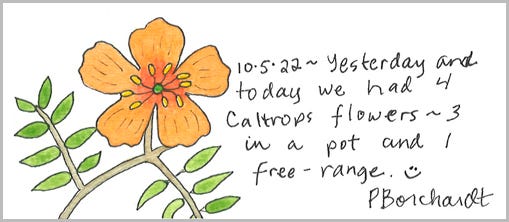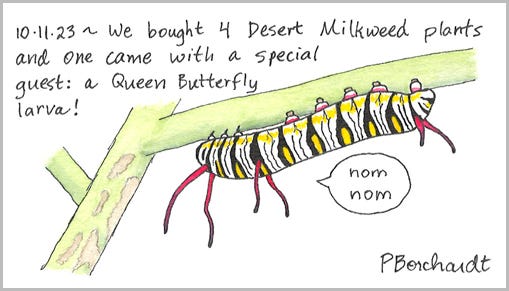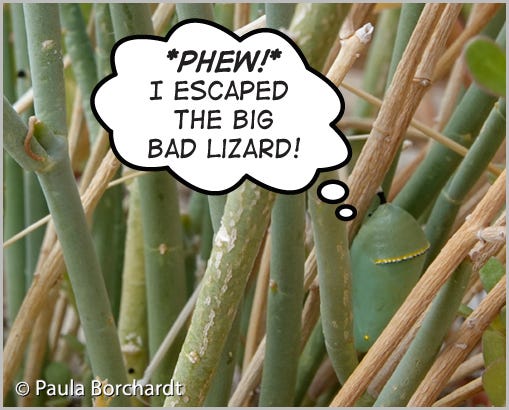Leapin’ Lizards!
—When a Lizard Friend Becomes a Frenemy
I almost always* enjoy seeing lizards and other reptiles in our yard. Just this past week, Hubby & I were fortunate enough to see a Gila Monster 😍 in our yard as well as a Gopher Snake about 2’ off the ground, up in our Chihuahuan Sage shrub.
In Summer we often see Desert Spiny Lizards chillaxing in the shade of our covered patio, and they’re almost always* welcome to do so. When I illustrated a Desert Spiny Lizard for a recent Perpetual Journal page, it happened to be on the same PJ page on which I’d illustrated a Western Banded Gecko in 2023. This provided a good opportunity to show the different types of lizard scales, using the call-outs you see below.

* About that Asterisk!
I’ve been happy to have Desert Spiny Lizards hang out on our patio until a lizard recently got too clever for my liking!
Humans vs. Lizard, Round 1
Our Caltrops (a native wildflower) had been growing nicely in a large pot by our patio until recently, when the flowers that bloomed in the morning disappeared by mid-morning. We noticed a Desert Spiny Lizard (which I’ll abbrev. DSL) had been hanging out near that pot; we suspected the DSL had somehow got up in the pot (a 20” tall pot with slick sides—both factors that we thought might make it fairly lizard-proof).
Here’s my art of Caltrops—one of my very first Perpetual Journal entries from way back in 2022!
Guessing that our DSL friend (quickly becoming a frenemy) had jumped to the pot from an adjacent plant stand, we placed fencing in the pot just inside the rim, encircling everything growing in the pot.
That failed to discourage our frenemy, as a couple days later I found a DSL (I’m guessing the same one) in the Caltrops pot. I had to get pretty close to the DSL to get it to jump up on the fencing and then out of the pot.
We don’t mind sharing some of our Caltrops flowers with lizards, but not Every. Single. Flower! The Caltrops flowers attract pollinators like native bees and we collect the seeds for planting more Caltrops.
Figuring that the DSL was still jumping from the plant stand to the Caltrops pot, Hubby & I scooted the pot 2’ away from the plant stand. Since then, no more Caltrops flowers have “mysteriously” disappeared. 🙂
Round 1 score:
Humans: 1 // Lizard: 1
Humans vs. Lizard, Round 2
In case you’re thinking, “Gee, Paula, don’t you have bigger picture issues to worry about than lizards on your patio?”—of course I do, with all the $#!+ going on in the world—and going outside to observe and get curious about nature is a great antidote to world events!
Hubby & I grow Milkweeds in our yard and in pots on our patio specifically as a nectar source for butterflies and as a host plant for Monarch and Queen Butterfly larvae (caterpillars). It’s our small way of trying to help declining butterfly populations. We’ve placed pots of Milkweeds on the top shelf of our plant stands (30” off the ground) to keep butterfly larvae safe(r) from predators like DSLs.
Here’s a Queen Butterfly larva I illustrated for my PJ in 2023—our first Queen larva! 🥰
We recently saw a Queen Butterfly laying eggs on our Milkweeds and by Thursday September 4, eight Queen larvae had hatched!
The following Saturday the larvae population had decreased to four, and I found a DSL on the top level of our plant stand right next to our Milkweeds. 😕 Knowing that DSLs can climb (we’ve seen them climb up the shade cloth we’ve hung down the sides of our plant stands), we rolled up and secured the shade cloth under pots.
Hubby & I are okay with sharing the caterpillars with lizards (lizards need to eat, too, after all—but not Every. Single. Caterpillar!). I doubt it understands, though, that eating every caterpillar is like overfishing the ocean—taking too many fish means there won’t be enough left to sustain fish populations.
On Sunday we saw four larvae in the afternoon but only two later, so we moved the larva in the shorter of the two pots to the taller pot where the other larva was—a 14” tall pot with slick sides that we hoped made the pot lizard-proof.
By Tuesday both larvae had grown a lot and looked big enough to pupate!
On Wednesday I checked on our larvae friends and found a DSL sitting in the taller Milkweed pot and no larvae in that pot! 😠To say I was surprised to see the DSL in the pot is an understatement and I had to prod the DSL with a trowel to get it to jump out of the pot and run off! Thankfully, one of the larvae had migrated back to the shorter pot earlier and was still alive!
Hubby & I noticed that one piece of our rolled-up shade cloth had fallen down, so we guessed that the DSL noticed that, too, and used it to climb up to the taller pot. 😠How it scaled the slick sides of the pot is a mystery to us.
We rolled up the shade cloth once again and moved the one remaining larva to yet another Milkweed for safekeeping, about 8’ away. We were relieved to see on Thursday that our remaining larva had pupated! Here’s a photo of that triumph over adversity.
Round 2 score:
Humans: 1 // Lizard: 7
Final score:
Humans: 2 // Lizard: 8
We estimate that our Queen pupa will eclose as a butterfly any day now—perhaps today or tomorrow!
“Don’t ever be ashamed of loving the strange things that make your weird heart happy.”
- Elizabeth Gilbert
Thank you for being here! I appreciate it. See you next week!
You can leave a comment or ask a question…
…and if you’ve enjoyed this, please share this post. Sharing makes the work involved in creating my posts even more worthwhile!





